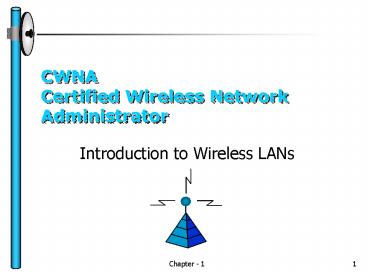CWNA Certified Wireless Network Administrator PowerPoint PPT Presentation
1 / 28
Title: CWNA Certified Wireless Network Administrator
1
CWNACertified Wireless Network Administrator
- Introduction to Wireless LANs
2
The Wireless LAN Market
- Wireless local area network (WLAN) market.
- Expected to reach US4.6 billion by 2005.
- WLAN product shipments should increase by over
US600 million per year from 2001 to 2005. - The 802.11b products have been especially
successful in penetrating the education,
hospitality, healthcare and financial
environments.
3
History of Wireless LANs
- 1830 Professor Joseph Henry transmitted the
first practical electrical signal. - 1969 The Advanced Research Projects Agency
Network (ARPANET) of the U.S. DoD was the world's
first operational packet Switched network.
4
History of Wireless LANs
- 1970 ALOHAnet was developed at the University
of Hawaii. - First wireless packet-switched network.
- First network to connect to the ARPANET in 1972.
- Star topology using 9600 Baud modems.
- Shared signal system using carrier sense multiple
access. - The ALOHAnet used two 100 kHz "channels" at
407.350 MHz and 413.475 MHz.
5
History of Wireless LANs
- 1985 Federal Communication Commission (FCC).
Authorized license-free spread spectrum wireless
equipment in three ISM bands. - 900 MHz band, (900 to 928 MHz range)
- 2.4 GHz band, (2.4 to 2.483 GHz range)
- 5 GHz band, (5.725 to 5.850 GHz range)
6
History of Wireless LANs
- 1997 Federal Communication Commission (FCC).
Authorized license-free spread spectrum wireless
equipment in three U-NII bands. - 5.15 to 5.25 GHz
- 5.25 to 5.35 GHz
- 5.725 to 5.825 GHz
7
Todays Wireless LAN Standards
- 1865 The International Telecommunication Union.
- Radiocommunication (ITU-R)
- Telecommunication Standardization (ITU-T)
- Telecommunication Development (ITU-D)
8
Todays Wireless LAN Standards
- 1934 The Federal Communications Commission (FCC)
is an independent United States government
agency. - FCC is charged with regulating interstate and
international communications by radio,
television, wire, satellite and cable.
9
Todays Wireless LAN Standards
- Institute of Electrical and Electronics
Engineers, Inc., IEEE, (Eye-triple-E). - IEEE is non-profit, technical professional
association of more than 380,000 individual
members in 150 countries. - IEEE has nearly 900 active standards with 700
under development.
10
Todays Wireless LAN Standards
- 1999 The Wi-Fi Alliance is a nonprofit
international association formed to certify
interoperability of wireless Local Area Network
products based on IEEE 802.11 specification. - 210 member companies from around the world
- 865 products have received Wi-Fi certification.
- The goal of the Wi-Fi Alliance's members is to
enhance the user experience through product
interoperability.
11
Todays Wireless LAN Standards
- 1997 IEEE 802.11
- Original wireless LAN standard
- Up to 2Mbps in the 2.4GHz band
- Modulation FHSS or DSSS
- Security WEP WPA
- Compatible with b and g
12
Todays Wireless LAN Standards
- 1999 IEEE 802.11b
- Up to 11Mbps in the 2.4GHz band
- Modulation DSSS with CCK
- Security WEP WPA
- Wi-Fi Certified
- Compatible with 802.11 and g
13
Todays Wireless LAN Standards
- 1999 IEEE 802.11a
- Up to 54Mbps in the 5GHz band
- Modulation OFDM
- Security WEP WPA
- Wi-Fi Certified
- Not Compatible with 802.11, b and g
14
Todays Wireless LAN Standards
- 2003 IEEE 802.11g
- Up to 54Mbps in the 2.4GHz band
- Modulation OFDM above 20Mbps, DSSS with CCK
below 20Mbps - Security WEP WPA
- Wi-Fi Certified
- Compatible with 802.11 and b
15
Todays Wireless LAN Standards
- 1998 Bluetooth
- Up to 2Mbps in the 2.45GHz
- Modulation FHSS
- Security PPTP, SSL or VPN
- The Infrared Data Association, IrDA, is a
nonprofit organization whose goal is to develop
globally adopted specifications for infrared
wireless communication.
16
Three-Tier Network Design Model
- A hierarchical network design model described by
Cisco Systems, Inc.
Core Layer
Distribution Layer
Access Layer
17
Access Layer
- Access Layer
- The layer in which users connect to the rest of
the network. The access layer usually includes a
relatively large number of low- to medium-speed
access ports. This is the layer where many
wireless devices and protocols reside.
Access Layer
18
Access Role
Admin Host
Network Server
Network Printer
Wired Network
Access Point
Clients
Wireless Network
19
Distribution Layer
- The Distribution Layer distributes network
traffic between related access layers, it is
often the layer in which you define subnets. For
wireless think bridging.
Distribution Layer
20
Distribution Role
Point-to-Point Links
Antenna 2
Transmission Path
Antenna 1
Building 2
Building 1
21
Core Layer
- The Core Layer facilitates the efficient
transfer of data between interconnected
distribution layers. The core layer typically
functions as the high-speed backbone of the
enterprise network.
Core Layer
22
Core Role
Admin Host
Network Server
Network Printer
Access Point
Network Core
Poor Speed and Resiliency
Clients
Wireless Network
23
Network Extension
Third Floor
Second Floor
Access Point
First Floor
24
Last Mile Data Delivery
Hot Spot
Shopping Mall
WISP Antenna
Residential Homes
WISP Antenna
25
Mobility
Network Server
Wired Network
Access Point
Roaming
Warehouse
Sales Office
26
Small Office Home Office
Access Point
Laptop
Workstation
Internet Connection
Wall or Divider
27
Mobile Office
Point-to-Multipoint Links
Main Building
Campus
Portables
28
Summary
- Wireless Networking History
- Advances in Wireless Networking
- Reduced costs and increased availability
- FCC, IEEE, WI-FI Alliance
- IEEE 802.11, 802.11a, 802.11b, 802.11g
- Wireless Networking Core, Distribution and
Access Layers - WISP

